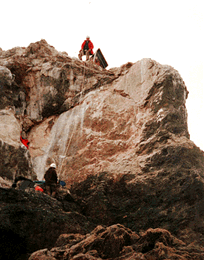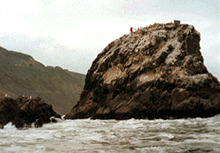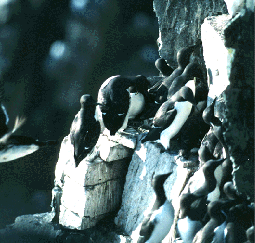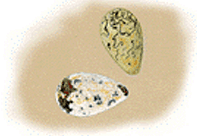
THIS YEAR,
it proved to be almost impossible. El Nino storms battered the rock
all winter while the biologists paced, impatient to populate the decoy
colony before the murre breeding season starts. "We've been on call
for months," says Dave Nothhelfer, celebrating his first anniversary
of working on the project. His boots are shredded and his pants are
duct-taped together at the ripped knees. "They just don't make gear
tough enough for field work," he says.
Just after dawn, on the first day of spring, the
sea is calm enough to boat out to Devil's Slide Rock. Onboard the 40-foot
fishing boat "Queen of Hearts", the Team Murre biologists, grinning
in excited anticipation, don bright orange survival jackets.
Everyone on the team has fallen into the ocean at
least once, except for Emilie Craig, who has worked on the project for
just three weeks. She smiles a bit uneasily.
Two weeks ago, during the first expedition of the
season, refuge biologist Jen Boyce slipped in up to her waist when she
leapt onto the island. It rained that day, "and it was like being in
a sea of guano," Boyce says. "My mom asks me why I'm doing this," she
says, her eyes flashing in anticipation of attacking the rock again.
The boat's route from Half Moon Bay harbor north
to Devil's Slide Rock veers around an infamous surf spot called "Mavericks,"
where 10-20 foot waves swell up routinely, and 30-foot waves sometimes
break. Several late surfers, some of them seasoned veterans, caught
their last waves at Mavericks. It's "extreme," as the surfers say.
Reviving the murre colony on Devil's Slide Rock may
be the Mavericks of field biology.
 JUST
AS with humans, location is everything in avian real estate, and the
murres couldn't pick a more beautiful spot to raise a family. The boat
ride offers an even more dramatic view of the coastline 25 miles south
of San Francisco than the drive along Highway 1. You may not have visited
in person, but you've driven this highway during commercial breaks in
your favorite t.v. show. Car companies exploit the crashing surf, rugged
rock islands and cliffs, and sweeping ocean views to imbue their newest
sedans and convertibles with a sense of adventure. JUST
AS with humans, location is everything in avian real estate, and the
murres couldn't pick a more beautiful spot to raise a family. The boat
ride offers an even more dramatic view of the coastline 25 miles south
of San Francisco than the drive along Highway 1. You may not have visited
in person, but you've driven this highway during commercial breaks in
your favorite t.v. show. Car companies exploit the crashing surf, rugged
rock islands and cliffs, and sweeping ocean views to imbue their newest
sedans and convertibles with a sense of adventure.
The power of nature is palpable here, even on land.
Devil's Slide has slid again. The steep hillside (practically a cliffside)
above the highway cuts off traffic every few years, and workers are
once more trucking away the season's debris. Below the highway is the
scar of a railroad track that connected Half Moon Bay to San Francisco
until its foundation slid into the ocean in 1925. Carter, who has studied
seabirds all along the west coast, thinks the highway will follow the
railroad in 10 or 20 years.
Once the Queen of Hearts (so dubbed before Diana's
death) nears Devil's Slide Rock, the biologists jump ship into a rubber
Zodiac raft. Propelled by an outboard motor, the 14-foot Zodiac is maneuverable
enough and sufficiently shallow-drafted to butt up against the rock
island. The scientists load the raft with bags of decoys, cargo nets,
ropes, and food and water for the long day atop the rock.
CATCHING
a small swell, Carter surfs the Zodiac straight at the towering cliff
face of Devil's Slide Rock. The biologists' harrowing first step from
the Zodiac onto the island is a narrow ledge lined with gooseneck barnacles
and California mussels. On each approach, one crew member must leap
from the Zodiac, as it rides the cresting wave, onto the ledge and cling
to the rock as the waves break over their boots. They adjust their helmets,
harness themselves into rock climbing ropes and ascend the slick sides
to finish constructing this year's colony.
The adult murre decoys, 350 of them, stand at attention
atop the island. They do not move, but it sounds as though they are
calling -- and loudly. The piped in murre music carries across the cove.
Parker tape recorded a murre colony on the Farallone Islands, and now
loudspeakers blare the chorus perpetually. Solar panels fuel marine
rechargeable batteries to keep up the din. Murres produce squawky, croaky
calls. When they're really excited, they sound like they're playing
the kazoo.
In between the solar panels and decoys, 10 mirrors
are propped up so that arriving, live murres will see their reflected
movements. Otherwise, the colony could look a bit lifeless. Boat captain
Bob Ingals cocks his head and puts on a puzzled face to imitate an incoming
murre greeting a decoy. "Dude! You sure don't talk much, do ya?" The
bearded, heavy captain looks a bit like a jolly Ernest Hemingway.
Today the biologists are adding wooden murre eggs
and 8 inch tall chick decoys to the colony. The decoys must be removed
each summer to scrape off all the guano. The black and white chicks
are lined with felt, so they have that just-born baby bird look. "We
have to re-fuzz them every year," says Boyce. The scientists have to
remove the whitened decoys at the end of the season to scrape off the
guano. They then replace them, freshly scrubbed, before the next breeding
season begins. After today, the staged murre colony will be complete.
 BREEDING
conditions in a real, thriving murre colony would send a claustrophobe
into fits. Hundreds of birds crowd onto a cliff face. The foot-and-a-half
tall birds, with black backs, black heads and white bellies (they look
a lot like penguins, but don't tell an ornithologist that), greet their
life-long mates each spring when they return to "their" nesting spot
to court and breed. The male throws his head back, pointing his bill
up in the air. Both sexes bow at each other, stroke each other's bills
and preen each other. They build no nests, but unceremoniously lay their
eggs wherever there is a bare patch of ledge. Birds pile on top of each
other as they incubate the eggs. BREEDING
conditions in a real, thriving murre colony would send a claustrophobe
into fits. Hundreds of birds crowd onto a cliff face. The foot-and-a-half
tall birds, with black backs, black heads and white bellies (they look
a lot like penguins, but don't tell an ornithologist that), greet their
life-long mates each spring when they return to "their" nesting spot
to court and breed. The male throws his head back, pointing his bill
up in the air. Both sexes bow at each other, stroke each other's bills
and preen each other. They build no nests, but unceremoniously lay their
eggs wherever there is a bare patch of ledge. Birds pile on top of each
other as they incubate the eggs.
These crowded conditions would seem to pose certain
problems for the birds. How do Ma and Pa Murre recognize their egg among
the hundreds of other eggs nearby? Once their chick hatches, how do
they keep track of it? Murre eggs are mottled with pigments laid down
as the egg passes through the mother's birth canal. The eggshell pattern
is distinctive, and both parents learn to recognize the egg shortly
after it is laid. Similarly, they learn to recognize the chick once
it hatches, so they can be sure to tend to their own progeny. Even though
each bird's kazoo-like call sounds the same to human ears, murres distinguish
each other's vocalizations. The chick begins to call while it is still
in the egg. Once it hatches, it calls back and forth with the parents
in a raucous but heart-felt family bonding ritual.
After only three weeks on the colonial rock, the half-grown
chick flaps down into the ocean and learns to feed. The father shepherds
the chick around for another one to two months. The father and child
call back and forth across the waves, maintaining contact with each
other through their squawks. Only in the common murre, as far as bird
biologists know, do exclusively fathers teach and guard the chick after
it leaves the nest.
THE COMMON
murre is the latest in a string of clients that National Audubon Society
biologist Steve Kress (and realtor to the winged) has helped find new
homes. He invented the decoy-loudspeaker-mirror method in the 1970s,
and he consults on the murre restoration effort. He knew that hunters,
exploiting birds' instinct to seek safety in numbers, set out decoys
so that their game would land in a convenient lake. Kress's ruse serves
a more animal-friendly purpose than hunting. "Instead of luring them
into guns, we are luring them into a safe place to nest," Kress said.
Wildlife restoration is all about history -- which
animals used to live here, what killed them or drove them away, and
how present conditions can mimic historical ones in order to bring the
animals back. Kress's original project, enticing puffins and terns to
return to islands off the coast of Maine, is rooted in the turn-of-the-century
fashion industry and the birth of America's wildlife conservation movement.
It started with ladies' hats. Egrets, herons and terns,
who flaunt bright, billowy breeding plumage during the season of love,
were hunted almost to extinction so that their feathers (fetching $32
an ounce) could grace high-class ladies' hats. Horrified ornithologists
and nature lovers fought -- and won -- the nation's first conservation
battle. The United States outlawed plume hunting, allowing the remaining
herons, egrets and terns to shake their feathers at their beloveds in
peace. The battle gave birth to the country's first wildlife conservation
organization, the National Audubon Society, founded in 1905 and named
after ornithologist and painter John James Audubon (1785-1851), who
killed birds for scientific or artistic purposes only.
Change can come slowly within wildlife conservation
movements. Seventy years after plume hunting was outlawed, the National
Audubon Society shifted its efforts from protecting plumed birds to
bringing them back to places where they had been wiped out. Kress's
1978 mission was to lure arctic and common terns to rocky islands off
of the Maine coast. He built decoys, and the birds came. Loudspeakers
and mirrors made the site look and sound like a teeming colony. His
trick has now been adopted by biologists in Hawaii, Japan, and -- to
return to the common murre -- in California.
 THE
MURRE'S deadliest enemy isn't plume hunters, but oil. Devil's Slide
Rock had hosted a thriving colony of common murres until 1986, when
an Apex Oil Company barge spilled 25,000 gallons of oil, coating beaches
from Monterey to Pt. Reyes. In one of California's worst spills on record,
at least 6,500 common murres were killed. Those who survived the spill
at Devil's Slide Rock abandoned the nesting site. THE
MURRE'S deadliest enemy isn't plume hunters, but oil. Devil's Slide
Rock had hosted a thriving colony of common murres until 1986, when
an Apex Oil Company barge spilled 25,000 gallons of oil, coating beaches
from Monterey to Pt. Reyes. In one of California's worst spills on record,
at least 6,500 common murres were killed. Those who survived the spill
at Devil's Slide Rock abandoned the nesting site.
For 10 years after the Apex spill, no murres ventured
to Devil's Slide Rock. The birds are particular about where they nest,
and they have long memories. Back in 1908, for example, egg hunters
disturbed a breeding colony on nearby San Pedro Rock. No murres have
returned to breed there since.
Apex was charged under the Clean Water Act and the
National Marine Sanctions Act with destruction of national resources.
The oil company fought a bitter, five-year court battle but was ultimately
fined $6.5 million. A slice of that money now funds the murre restoration
project, overseen by the U.S. Fish and Wildlife Service.
"This is exactly where the money should be spent,"
says Carter, circling Devil's Slide Rock in the Zodiac. He had taken
census of several murre colonies, including  the
one on Devil's Slide Rock, before the oil spill, so he was able to help
the government document the damage the spill caused. He also walked
the area's beaches after the spill, counting dead birds. the
one on Devil's Slide Rock, before the oil spill, so he was able to help
the government document the damage the spill caused. He also walked
the area's beaches after the spill, counting dead birds.
Translating settlement money into larger numbers of
common murres is a complex project. The immediate goal is to reestablish
a breeding colony where Apex oil had driven one away. At its peak, Devil's
Slide Rock hosted 2,900 murres. The larger goals are to help the local
murre population return to its pre-spill numbers and to protect the
species from future ecological disasters. The more breeding colonies
spread out along the coast, the better the chances that at least some
will escape the next oil spill. Biologists know better than to keep
all their eggs in one breeding colony.
<<
previous
|| next >>
|


 JUST
AS with humans, location is everything in avian real estate, and the
murres couldn't pick a more beautiful spot to raise a family. The boat
ride offers an even more dramatic view of the coastline 25 miles south
of San Francisco than the drive along Highway 1. You may not have visited
in person, but you've driven this highway during commercial breaks in
your favorite t.v. show. Car companies exploit the crashing surf, rugged
rock islands and cliffs, and sweeping ocean views to imbue their newest
sedans and convertibles with a sense of adventure.
JUST
AS with humans, location is everything in avian real estate, and the
murres couldn't pick a more beautiful spot to raise a family. The boat
ride offers an even more dramatic view of the coastline 25 miles south
of San Francisco than the drive along Highway 1. You may not have visited
in person, but you've driven this highway during commercial breaks in
your favorite t.v. show. Car companies exploit the crashing surf, rugged
rock islands and cliffs, and sweeping ocean views to imbue their newest
sedans and convertibles with a sense of adventure.  BREEDING
conditions in a real, thriving murre colony would send a claustrophobe
into fits. Hundreds of birds crowd onto a cliff face. The foot-and-a-half
tall birds, with black backs, black heads and white bellies (they look
a lot like penguins, but don't tell an ornithologist that), greet their
life-long mates each spring when they return to "their" nesting spot
to court and breed. The male throws his head back, pointing his bill
up in the air. Both sexes bow at each other, stroke each other's bills
and preen each other. They build no nests, but unceremoniously lay their
eggs wherever there is a bare patch of ledge. Birds pile on top of each
other as they incubate the eggs.
BREEDING
conditions in a real, thriving murre colony would send a claustrophobe
into fits. Hundreds of birds crowd onto a cliff face. The foot-and-a-half
tall birds, with black backs, black heads and white bellies (they look
a lot like penguins, but don't tell an ornithologist that), greet their
life-long mates each spring when they return to "their" nesting spot
to court and breed. The male throws his head back, pointing his bill
up in the air. Both sexes bow at each other, stroke each other's bills
and preen each other. They build no nests, but unceremoniously lay their
eggs wherever there is a bare patch of ledge. Birds pile on top of each
other as they incubate the eggs.  THE
MURRE'S deadliest enemy isn't plume hunters, but oil. Devil's Slide
Rock had hosted a thriving colony of common murres until 1986, when
an Apex Oil Company barge spilled 25,000 gallons of oil, coating beaches
from Monterey to Pt. Reyes. In one of California's worst spills on record,
at least 6,500 common murres were killed. Those who survived the spill
at Devil's Slide Rock abandoned the nesting site.
THE
MURRE'S deadliest enemy isn't plume hunters, but oil. Devil's Slide
Rock had hosted a thriving colony of common murres until 1986, when
an Apex Oil Company barge spilled 25,000 gallons of oil, coating beaches
from Monterey to Pt. Reyes. In one of California's worst spills on record,
at least 6,500 common murres were killed. Those who survived the spill
at Devil's Slide Rock abandoned the nesting site.  the
one on Devil's Slide Rock, before the oil spill, so he was able to help
the government document the damage the spill caused. He also walked
the area's beaches after the spill, counting dead birds.
the
one on Devil's Slide Rock, before the oil spill, so he was able to help
the government document the damage the spill caused. He also walked
the area's beaches after the spill, counting dead birds.